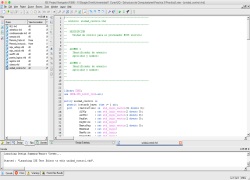

- #Start xilinx ise 14.7 in linux mint how to
- #Start xilinx ise 14.7 in linux mint install
- #Start xilinx ise 14.7 in linux mint driver
- #Start xilinx ise 14.7 in linux mint license
steps and add /opt/Petalinux/petalinux-v2015.4-final/components/linux-kernel/xlnx-4.0/include.
Select /opt/Petalinux/petalinux-v2015.4-final/components/linux-kernel/xlnx-4.0/arch/arm/include and click OK. Check Add to all configurations and click File system. Now select Paths and Symbols on left menu:. Uncheck Use global provider shared between projects and add -nostdinc to Command to get compiler specs. Now click on Providers tab and check CDT GCC Built-in Compiler Settings. Set File to /home/d9/Projects/ZedBoardPetalinux/build/linux/kernel/xlnx-4.0/include/generated/autoconf.h. Select File System Path in top-right left drop-down menu. Select Preprocessor Macros File in top-left drop-down menu. Select CDT User Settings Entries for Settings Entries. Select Preprocessor Include Paths, Macros etc. Uncheck Index source files not included in the build and check Index all header variants. Check Enable project specific settings. In C/C++ General properties for AXIDMAProject:. Select Xilinx ARM GNU/Linux Toolchain for Toolchain. Set Project Type to Makefile Project > Empty Project. Xsdk -vmargs -Xms1024m -Xmx2048m -XX:+UseParallelGC So, start Xilinx SDK with extra memory for indexer: Linux kernel sources is a huge collection of files and Eclipse indexer needs lots of memory. HowTo use the CDT to navigate Linux kernel sourceĬonfiguring Eclipse for Linux Kernel module development But most steps are universal, you just have to setup cross-compiler and possibly some missing packages, like sshpass and scp. #Start xilinx ise 14.7 in linux mint how to
Reg = < 0x40400000 0x10000> Ĭompatible = "xlnx,axi-dma-s2mm-channel" ĭmas = < & axidma0 0> Ī small HowTo (and reminder for myself) on how to use Eclipse (Xilinx SDK) to develop, cross-compile and upload Linux kernel modules for Zynq (ARM-based) embedded board using Xilinx SDK and Xilinx Embedded Linux aka Petalinux. So, below example of DTS node for AXI DMA and modified xilinx_dmatest(single channel) which works for me for Linux 4.4 Also, if you using the only one DMA-channel either MM2S or S2MM channel index in your custom DTS node must be 0 in either case, unlike before if you were using only s2mm index was 1 and if only mm2s index was 0.
#Start xilinx ise 14.7 in linux mint driver
This time it complained that it can't find DMA channel: "unable to read dma-channels property" and as result "Probing channels failed." So, looks like Xilinx added support for "multi-channel mode" for kernel driver and this is a big deal! And I waited for this forever!īut, as a result of this - DTS node were changed again, braking compatibility. I recently switch to Linux Kernel 4.4 (from 4.0) for some of my projects and to my no surprise found Xilinx AXI-DMA not working again. # export LD_LIBRARY_PATH=/opt/Xilinx/Vivado/2016.2/lib/ln圆4.o # export LD_LIBRARY_PATH=/opt/Xilinx/Vivado/2016.2/lib/ln圆4.o:$LD_LIBRARY_PATH In my case, I noticed problems with starting gedit and failed compilation of U-boot with error "awk: undefined symbol: mpfr_z_sub".Īnyway, we actually can remove setting LD_LIBRARY_PATH from settings64.sh if your hardware design doesn't include AXI-BFM IP.
Yet another source of problems - Vivado's settings64.sh: it sets LD_LIBRARY_PATH to point to Vivado/2016.2/lib/ln圆4.o, but because its global it affects all binaries run within the shell where we source settings64.sh. Make changes to /etc/networking/interfaces and reboot: Warning: Setting GRUB_TIMEOUT to a non-zero value when GRUB_HIDDEN_TIMEOUT is set is no longer supported.įound linux image: /boot/vmlinuz-4.4.0-31-genericįound initrd image: /boot/initrd.img-4.4.0-31-genericįound linux image: /boot/vmlinuz-4.4.0-21-genericįound initrd image: /boot/initrd.img-4.4.0-21-genericįound memtest86+ image: /boot/memtest86+.elfįound memtest86+ image: /boot/memtest86+.bin Sudo grub-mkconfig -o /boot/grub/grub.cfg 
GRUB_CMDLINE_LINUX="net.ifnames=0 biosdevname=0"

In order to make a change we have to add next settings to grub config in /etc/default/grub". Looks like problem lies in new Ubuntu ethernet interface names and changing it back to eth0 fixes the issue.
#Start xilinx ise 14.7 in linux mint license
However, the host ID in the license file is correct.
Another problem I discovered is when I open the Xilinx License Configuration Manager (XLCM) in Vivado Design Suite 2016.2, the HOST ID Matches column is shown as No. I usually add them at the end of my ~/.bashrc: In order to run XSDK which can't use default GTK v3 we have to export new environmental variable. #Start xilinx ise 14.7 in linux mint install
Just a list of a few new steps required to install and run Vivado, XSDK and Petalinux 2016.2 on Ubuntu 64bit 16.04:







 0 kommentar(er)
0 kommentar(er)
